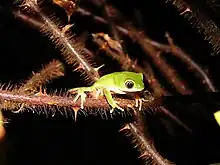Pithecopus
Pithecopus is a genus of frogs in the subfamily Phyllomedusinae.[2][1] Species of the genus Pithecopus are found in tropical South America east of the Andes, from southern Venezuela to northern Argentina.[1][3][4] Resurrected from the synonymy of Phyllomedusa in 2016, it corresponds to the former Phyllomedusa hypochondrialis group.[1][3] Its sister group is Callimedusa.[3]
| Pithecopus | |
|---|---|
 | |
| Pithecopus azureus, the type species | |
| Scientific classification | |
| Domain: | Eukaryota |
| Kingdom: | Animalia |
| Phylum: | Chordata |
| Class: | Amphibia |
| Order: | Anura |
| Family: | Hylidae |
| Subfamily: | Phyllomedusinae |
| Genus: | Pithecopus Cope, 1866 |
| Type species | |
| Phyllomedusa azurea Cope, 1862 | |
| Species | |
|
12 species (see text) | |
| Synonyms[1] | |
| |
Etymology
The name of this genus is derived from the Greek pithekodes, which means "ape-like".[3]
Description
Pithecopus are medium-sized frogs measuring about 45 mm (1.8 in) in snout–vent length. Toe I is much longer than toe II, and is opposable to it. No vomerine teeth are present. The tadpoles have a moderately small oral disc that is anteroventrally directed.[3]
Species
There are 12 species in this genus:[1]
- Pithecopus araguaius (Haga, Andrade, Bruschi, Recco-Pimentel, and Giaretta, 2017)
- Pithecopus ayeaye (Lutz, 1966)
- Pithecopus azureus (Cope, 1862)
- Pithecopus centralis (Bokermann, 1965)
- Pithecopus gonzagai (Andrade, Haga, Ferreira, Recco-Pimentel, Toledo, and Bruschi, 2020)
- Pithecopus hypochondrialis (Daudin, 1800)
- Pithecopus megacephalus (Miranda-Ribeiro, 1926)
- Pithecopus nordestinus (Caramaschi, 2006)
- Pithecopus oreades (Brandão, 2002)
- Pithecopus palliatus (Peters, 1873)
- Pithecopus rohdei (Mertens, 1926)
- Pithecopus rusticus (Bruschi, Lucas, Garcia, and Recco-Pimentel, 2014)
The AmphibiaWeb lists only two species (Pithecopus araguaius and Pithecopus gonzagai), the rest being included in Phyllomedusa.[2]
References
- Frost, Darrel R. (2020). "Pithecopus Cope, 1866". Amphibian Species of the World: An Online Reference. Version 6.1. American Museum of Natural History. doi:10.5531/db.vz.0001. Retrieved 16 December 2020.
- "Hylidae". AmphibiaWeb. University of California, Berkeley. 2020. Retrieved 16 December 2020.
- Duellman, William E.; Marion, Angela B. & Hedges, S. Blair (2016). "Phylogenetics, classification, and biogeography of the treefrogs (Amphibia: Anura: Arboranae)". Zootaxa. 4104 (1): 1–109. doi:10.11646/zootaxa.4104.1.1. PMID 27394762.
- Andrade, Felipe Silva de; Haga, Isabelle Aquemi; Ferreira, Johnny Sousa; Recco-Pimentel, Shirlei Maria; Toledo, Luís Felipe & Bruschi, Daniel Pacheco (2020). "A new cryptic species of Pithecopus (Anura, Phyllomedusidae) in north-eastern Brazil". European Journal of Taxonomy. 723: 108–134. doi:10.5852/ejt.2020.723.1147.